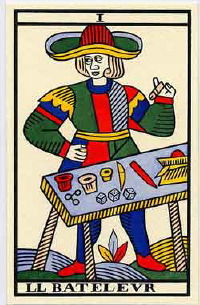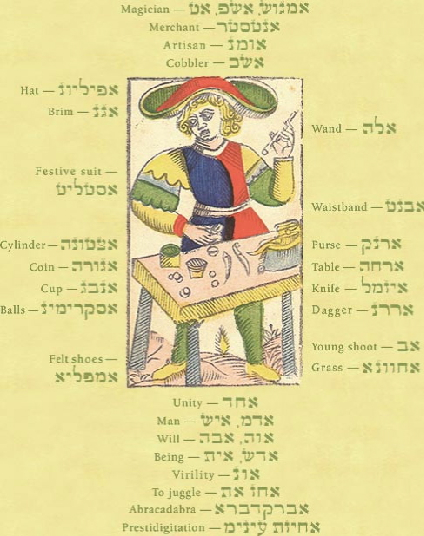| |
A Lexicon Theory of Tarot Origin
by Mark Filipas ®
The Tarot first appeared in northern Italy, during the
birth of Europe’s cultural revolution. Those original
decks were probably designed between 1420 and 1440, although
the earliest extant cards date from later in the 1400s.
The Marseilles pattern - so named because it characterizes
the decks traditionally produced in Marseilles, France
- is only one of several early variations. Nonetheless,
it represents one candidate for the earliest sequence of
trumps, and many of its images echo the earliest designs
from the 1400s. Its pattern can be traced back at least
to the 1660s with the Tarot by Jean Noblet, and to 1672
with the Tarot of François Chosson. Other well-known examples
of this pattern are the 1748 Tarot by Grimaud and the 1760
Tarot by Nicolas Conver [each still in print].
Since these creators left no manual for their decks,
we must look for explanatory clues in the details of the
designs themselves. We can also look to the cultural context
in which these cards first appeared. Yet while the designs
show a variety of influences - such as social hierarchy,
the Virtues, Biblical and classical allusions, astrology
and perhaps even alchemy - these do not adequately explain
why the Tarot’s early designers settled upon this
specific set of designs, or why they arranged the designs
in this particular sequence.
Did the Hebrew alphabet influence the early Tarot’s
design?
This question has been hotly debated now for more than
a century. At one end of the spectrum are those who argue
that the letters were fundamentally associated with the
trumps from the beginning. At the other end are those who
argue that there is no evidence to conclude any link between
the early Tarot and the Hebrew alphabet.
Various pages on my
website introduce new research showing a demonstrable
correspondence between the Hebrew letters and the Marseilles
Tarot. That correspondence lies within the medieval Hebrew
lexicon, which contains an alphabetical sequence of words
corresponding to the 22 allegorical subjects. Each trump,
in effect, illustrates one Hebrew letter in much the
same way as a child’s English primer echoes ‘A
is for apple’ and ‘B is for boy’. Not
only can the allegorical subjects be found in alphabetical
sequence, but virtually every item on each trump can
be found with the same initial letter, suggesting the
Tarot of Marseilles to be a ‘visual abecedarium’ of
the Hebrew alphabet.
 
Trump I - Magician (AT, AShP) - aleph
Trump II - Sibyl, Seer (BDQ, BOLH, BOL HZYH) - bet
Trump III - Queen (GBYRH) - gimel
Trump IV - Duke (DKS, DVS) - dalet
Trump V - Pontiff (HGMVN) - he
Trump VI - Love (VDO) - vav
Trump VII - Triumph (ZKH, ZKY) - zayin
Trump VIII - Judgement (ChYThVK) - chet
Trump IX - Time (TMPV), Wisdom (TOM) - tet
Trump X - Iynx, or Wheel of Fortune (YNQS) - yud
Trump XI - Strength (KCh, KChCh) - kaph
Trump XII - Informant (LYTYRYN), Thief (LYSTA) - lamed
Trump XIII - Death (MVTh, MYThH) - mem
Trump XIV - Temperance (NThChSM, NZYRVTh) - nun
Trump XV - Satan (STN) - samech
Trump XVI - Flash of light (ODY) - ayin
Trump XVII - Pleiades (PLYDVTh), Paradise (PRDS) - peh
Trump XVIII Conjunction (TzRVP) - tzaddi
Trump XIX - Summer (QYTz) - qoph
Trump XX - Sounding the trumpet (RVO, RAOThA) - resh (1)
Trump XXI - Portal of Heaven (ShOR HShMYM) , Heaven (ShMYM) - shin
The unnumbered card - Folly (ThHLH, ThPLH) - tav
An even closer look at the lexicon reveals that virtually
all of the iconographic details of a given card can be
found beginning with the same corresponding letter.
The first Hebrew letter aleph, for example, begins the
words for magician (AMGVSh, AShP), to juggle, to perform
magic tricks (AChZ OYNYM), festive suit (ASTLYTh), coin
(AGVRH), cup (ANBG), balls (ASQRYMYN), dagger (ARRN), knife
(AYZML), thin hollow tube (ABVB), purse or money bag (ARNQ),
and young shoot of a plant (AB). The eighth letter chet
begins the words for lawgiver (ChQQ), verdict (ChYThVK),
sword (ChRB), scales (ChRSPYThYN), sun (ChMH, the symbol
on Justice’s headdress), solar columns (ChMNYM),
screen partition (ChYTz), and rope around the neck (ChNQA).

The thirteenth letter mem begins the words for reaper
(MQTzRH), corpse (MTh), scythe (MGL), head (MVCh), crown
(MKLLThA), king (MLK), and queen (MLKH). The eighteenth
letter tzaddi begins the words for heavenly bodies (TzBA
HShMYM; early iconography shows the Sun and Moon conjunct),
hyenas (TzBVOYM), thirst (TzYCh, TzHH, TzMA), droplets
(TzChTzVCh), pincers (TzBTh), water (TzNYNYM), and the
Castle or Rook (TzRYCh) in the game of chess. These examples
are only the tip of the iceberg, as virtually every pictorial
element of the trumps can be found in alphabetical order
within the lexicon.
Like a visual encyclopedia, the Marseilles designs incorporate
a variety of influences, such as Biblical and literary
allusion, mythological figures, alchemical imagery, and
even the game of Chess-all in alphabetical sequence.
Was the Marseilles pattern based intentionally upon
the lexicon?
The following facts require us to examine this possibility
in detail:
-
The Marseilles subjects can be found in alphabetical
order within the Hebrew lexicon, yet cannot be found
in such order when the letters and trumps are correlated
arbitrarily. This body of correspondences argues against
(but does not rule out) coincidence.
-
Virtually every element in the designs can be found
in alphabetical order, yet cannot be found in such order
when the letters and trumps are correlated arbitrarily.
This singular body of links is presented here as well
as in An Alphabetic Masquerade.
-
The majority of Marseilles trumps show visual similarities
to the shape of its corresponding Hebrew letter, yet
a majority of similarities does not appear when the letters
and trumps are correlated arbitrarily.
-
The majority of Marseilles trumps illustrate the literal
meaning of its corresponding Hebrew letter. These meanings
are not those presented in any Tarot books to date but
can be found only in medieval Hebrew sources, as presented
here.
There are also points of historical context which support
the thesis that the trumps were designed as alphabetic
images, two of the most important being:
-
The interest in Hebrew lexicography at the time of
the Tarot’s appearance, and
-
Widespread traditions of alphabetic imagery at that
time. These pursuits (explored in the following pages)
existed right alongside those of cardmaking within the
print shops and art studios of the time.
Just as surprising are the details added by the Italian
artist Carlo Dellarocca into his 1835 Tarot designs. Whereas
the Marseilles’ iconography appears crude to modern
eyes, the Tarocchino Milanese is more intricately engraved
and its pictorial elements therefore more easily identifiable
within the lexicon. Dellarocca’s designs are also
distinguished by their inclusion of many unique objects.
I submit that these objects are the key to the Tarocchino
Milanese. Why? Because both their abundance and their singular
position within the Hebrew lexicon argues convincingly
that they are alphabetic allusions.
Dellarocca’s La Luna, for example, depicts a banquet
dish (TzOH, TzLChTh), a plate of fried fish (TzChNH), baying
at the moon (TzOQ HY VQYM), the landmark or pillar (TzYVN)
on the far shore, its conical roof (TzRYP), and the ship
(TzY, TzYM) in the distance. The entire list of Dellarocca
correspondences can be found on the site.
It is possible that the Tarocchino Milanese represents
the clarification of an earlier alphabetic tradition among
cardmakers. Or, it may simply represent Dellarocca’s
own alphabetic creativity. It should also be noted that
his 1835 designs appeared after the earliest known account
(by the esotericist Court de Gebelin in 1781) asserting
a link between the Tarot and the Hebrew alphabet (although
de Gebelin’s correspondences are not those evident
in Dellarocca’s trumps). It is therefore possible
that the writings of de Gebelin were known to Dellarocca.
In any case, Dellarocca was presumably following the traditions
of Italian artists who had long been incorporating alphabetic
allusion into their designs.
In other pages on my site, we will show that the Tarot emerged
from a culture well-versed in alphabetic imagery.
(1) The Latin word Ressurectio, being the subject of
this trump, is very likely to be found transliterated into
Hebrew in medieval sources, since the Hebrew language of
this period incorporated many of Latin’s most significant
words.
This article first appeared on Mark Filipas’s site, Exploring
the Alphabetic Tarot, reproduced with permission
Bibliography:
- Alcalay, Reuben. The Complete English-Hebrew Dictionary,
Massada, 1981.
- Alcalay, Reuben. The Complete Hebrew-English Dictionary,
Massada, 1981.
- Jastrow, Marcus, Ph.D. Litt.D. A Dictionary of the
Targumim, the Talmud Babli and the Yerushalmi, and the
Midrashic Literature, The Judaica Press, 1992 (first published
in 1903).
- Yehuda, Ehud Ben. English-Hebrew-English Dictionary,
Pocket Books, 1961
Thank you Mark for permission to republish this extract
from the website.
|
|